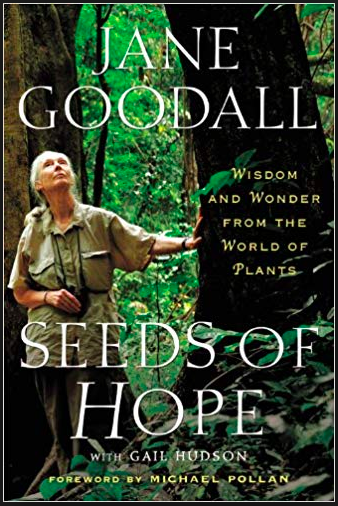When people think of Dr. Jane Goodall they think of her pioneering work into chimpanzee behaviour. She also happens to be the United Nations Messenger of Peace and a tireless global campaigner for environmental conservation. So I was excited to finally read her book ‘Seeds of Hope’ in the hopes of gaining an insight into her amazing life and work (and what drives her to travel three hundred days a year).
Unsurprisingly, her passion for nature started when she was a child living in war-torn Britain. Her escape spending time with the plants and trees in her family garden. Here, among the treetops she read books of far-flung adventures that fuelled her imagination that would ultimately lead her to Tanzania (where she did her chimpanzee research). Throughout the book, I couldn’t help but notice the spiritual reverence Dr. Goodall has for trees and indeed she refers to them as an ‘ancient life force’.

Like many of her peers, she identifies a number of threats to nature such as intensive industrial farming, climate change, ‘biopiracy’ and the rise of genetically modified organisms. She contrasts these threats with the values of protecting trees to society; maintaining a healthy ecosystem, cultural values, food, fibre and medicines. Interestingly, she even provides a brief history on the traditional and cultural significance of plants such as tobacco, opium and cocoa. She doesn’t blame these plants for the rifts it has created in society but blames society and commercial interests for co-opting them for their illicit purposes.
Throughout the book, she shares childhood memories with the readers. Some might find this reoccurring motif interesting while others might find that it interrupts the flow of the story. Upon reflection, I feel like these childhood memories (although incredibly insightful) would have been better off as an introductory and conclusion chapters or entirely separate as an autobiography. I also feel like Dr. Goodall could have expanded on some sections a bit more and supported her claims with scientific research, particularly, when she was talking about medicinal use of certain plants.
Personally, the most fascinating parts of the book were ones where she shares stories about interesting trees from around the world and the (often extreme) lengths some scientists and conservationists are going to to save them (such as the 4800 year old Methuselah plant). I also found some of the case studies of local projects to conserve nature extremely inspiring. Particularly, those that are being driven at the grassroots level by children such as the numerous ‘Roots & Shoots’ programs.

Ultimately, this book is a marvellous adventure through the unique lives of trees that aims to inspire its readers and is a worthy addition to my bookshelf. Reading the book has inspired me to pursue a new project about trees. I also have a new found love and respect for organisations (both big and small) that actively encourage people to plant trees.
‘Nature is resilient’ (Dr. Jane Goodall)


Come with me to see Old Tjikko.
LikeLike
Visiting Old Tjikko would be such an amazing experience. Where do I sign up?
LikeLike